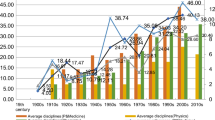Abstract
Following the ‘black–white swan’ interaction metaphor introduced in an earlier study, we now trace and observe a new ‘swan groups’ pattern. Our motivation for introducing the ‘swan groups’ is based on the fact that ‘black–white swan’ interactions are observed primarily in physics, which belongs to science. We extend a newer model called ‘swan groups’ model and test its applicability to the field of economics, belonging to social sciences. The primary feature of this model is that the ‘black swan’ represents an important scientific discovery or contribution that has been awarded Nobel Prize, while the ‘white swans’ are highly cited publications by the ‘black swan’. Together the two types of swans form a group, though unlike the original ‘black–white swan’ interaction pattern, the ‘swan groups’ do not necessarily interact in a way where we see a marked decrease in citations to white swans. Our findings show that the new ‘swan groups’ pattern covers about 50% of key Nobel prize-winning physics papers and about 40% of key Nobel prize-winning economic papers. This allows us to identify important academic achievements both qualitatively and quantitatively, not only in science where major breakthroughs can cause paradigm shifts, but also in the social sciences where progress often remains open to multiple discoveries and doctrines.





Similar content being viewed by others
References
Avramescu, A. (1979). Actuality and obsolescence of scientific literature. Journal of the American Society for Information Science, 30(5), 296–303.
Braun, T., Glänzel, W., & Schubert, A. (2010). On sleeping beauties, princes and other tales of citation distributions. Research Evaluation, 19(3), 195–202.
Du, J., & Wu, Y. (2018). A parameter-free index for distinguishing sleeping beauties in science. Scientometrics, 116(2), 959–971.
Erdem, O. (2016). A paradigm shift in economics. Unpublished manuscript. Retrieved August 27, 2018 from https://core.ac.uk/download/pdf/51100307.pdf.
Gorraiz, J., Purnell, P., & Glänzel, W. (2013). Opportunities and limitations of the book citation index. Journal of the American Society for Information Science and Technology, 64(7), 1388–1398.
Hirsch, J. (2005). An index to quantify an individual’s scientific research output. Proceedings of the National Academy of Sciences of the USA, 102(46), 16569–16572.
Ke, Q., Ferrara, E., Radicci, F., & Flammini, A. (2015). Defining and identifying sleeping beauties in science. Proceedings of the National Academy of the Sciences of the USA, 112(24), 7426–7431.
Kuhn, T. S. (1962). The structure of scientific revolutions. Chicago: University of Chicago Press.
Li, J., & Ye, F. Y. (2012). The phenomenon of all-elements-sleeping-beauties in scientific literature. Scientometrics, 92(3), 795–799.
van Raan, A. F. J. (2004). Sleeping beauties in science. Scientometrics, 59(3), 467–472.
van Raan, A. F. J. (2017). Sleeping beauties cited in patents: Is there also a dormitory of inventions? Scientometrics, 110(3), 1123–1156.
Zeng, C. J., Qi, E. P., Li, S. S., Stanley, H. E., & Ye, F. Y. (2017). Statistical characteristics of breakthrough discoveries in science using the metaphor of black and white swans. Physica A, 487, 40–46.
Zhang, R. J., Zeng, C. J., & Ye, F. Y. (2017). The characteristic measures of “3S” special citation phenomena with academic implications: A synthetic essay on the “sleeping beauty”, “smart girl” and “swan”. Journal of the China Society for Scientific and Technical Information, 36(12), 1–6. (in Chinese).
Zuccala, A., Breum, M., Bruun, K., & Wunsch, B. T. (2018). Metric assessments of books as families of works. Journal of the Association for Information Science and Technology, 69(1), 146–157.
Acknowledgements
The authors acknowledge National Natural Science Foundation of China Grant No 71673131, support by the International Joint Informatics Laboratory operated cooperatively by the University of Illinois at Urbana–Champaign, USA and Nanjing University, China.
Author information
Authors and Affiliations
Contributions
HHZ collected data and processed data, AAZ checked the research and wrote the paper, FYY initiated the idea and wrote the paper.
Corresponding author
Ethics declarations
Conflict of interest
The authors declare that they have no conflict of interest.
Rights and permissions
About this article
Cite this article
Zhang, H.H., Zuccala, A.A. & Ye, F.Y. Tracing the ‘swan groups’ of physics and economics in the key publications of nobel laureates. Scientometrics 119, 425–436 (2019). https://doi.org/10.1007/s11192-019-03036-9
Received:
Published:
Issue Date:
DOI: https://doi.org/10.1007/s11192-019-03036-9




